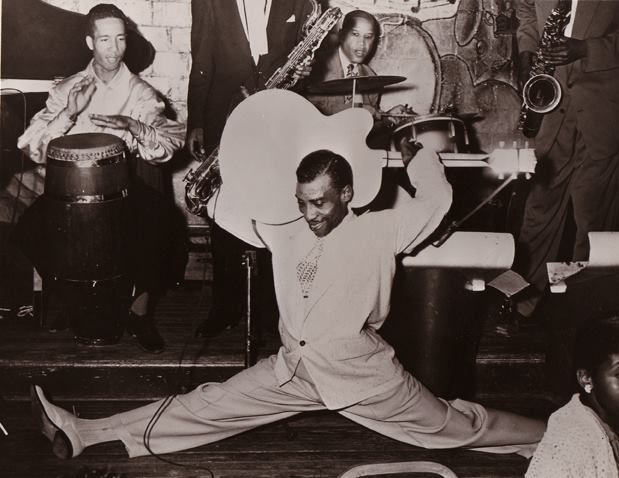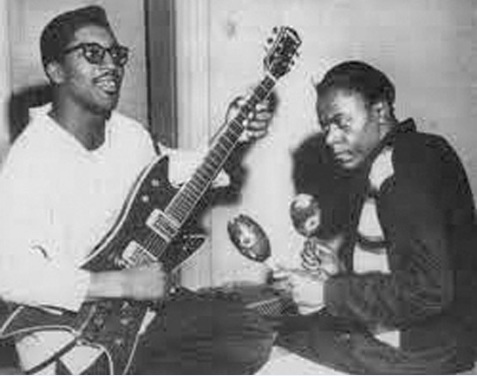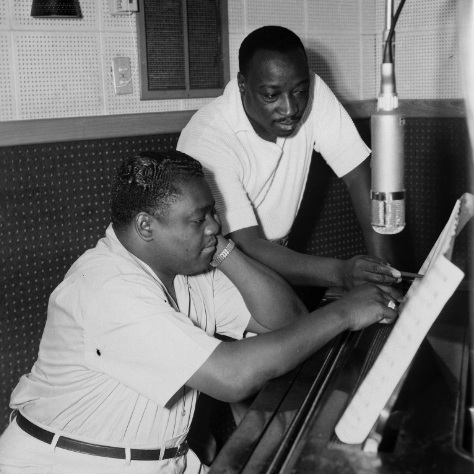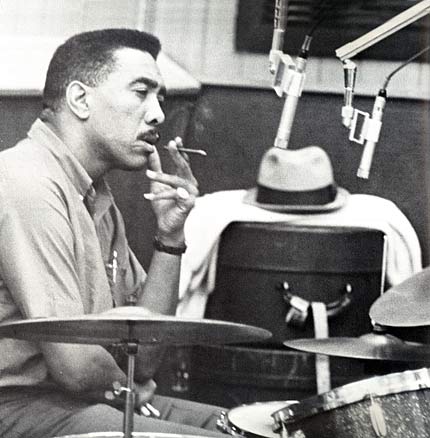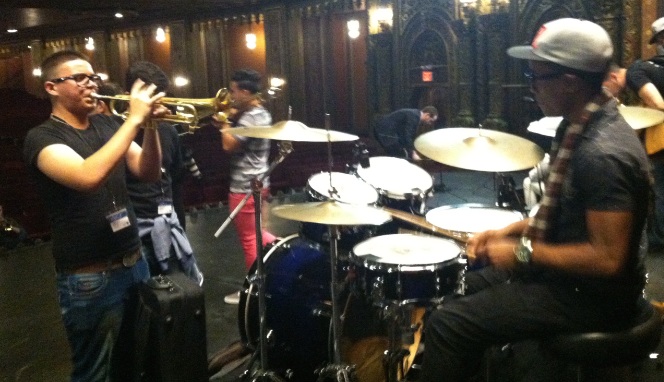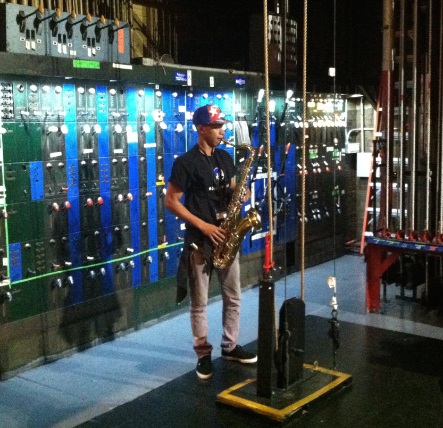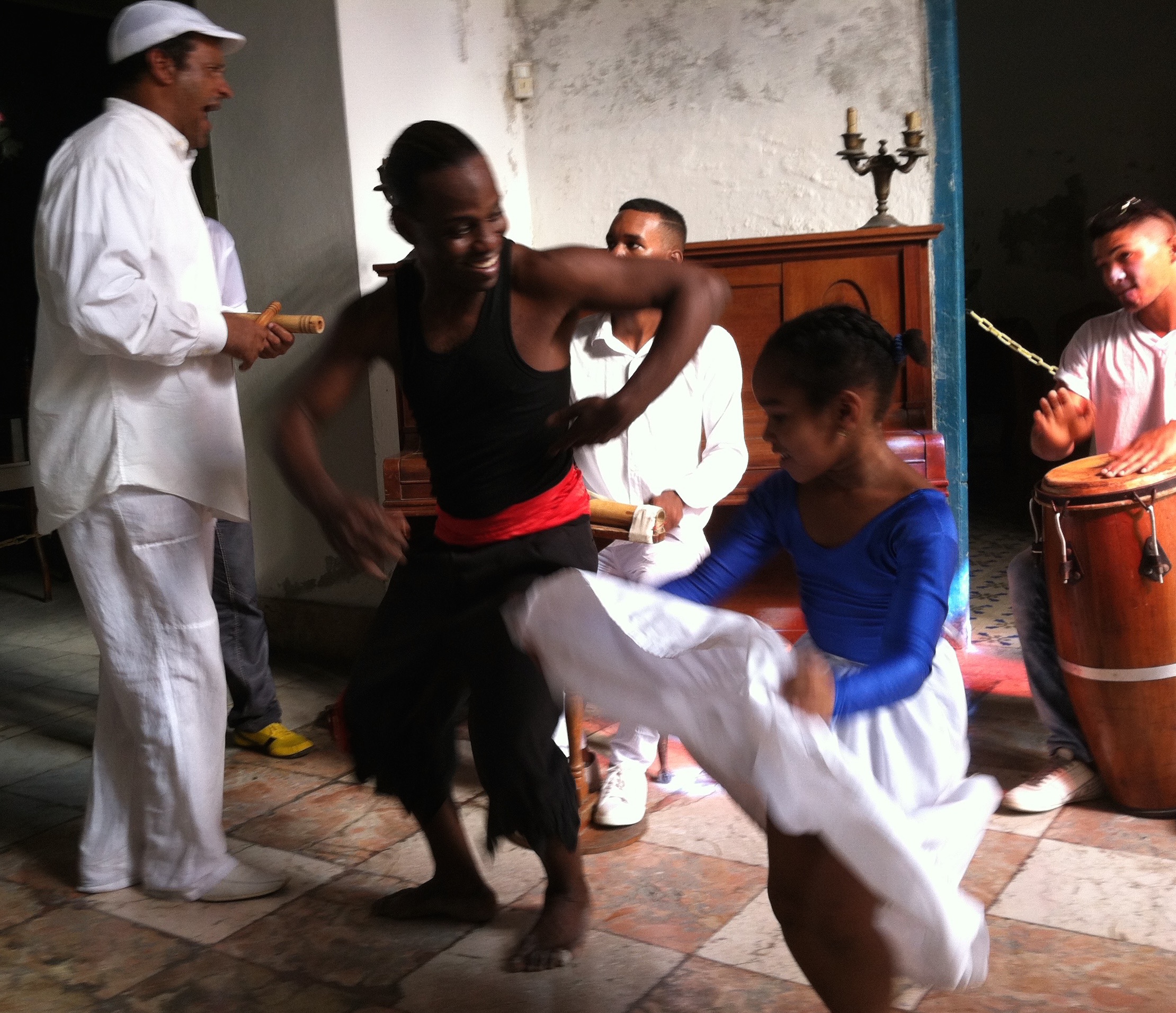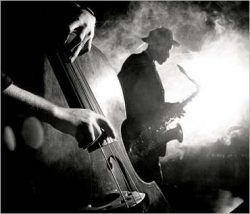Blog, Cuba, The Cuba-US connection
Before US trade and travel restrictions over 50 years ago, Cuba’s rich musical output was widely enjoyed in the US via records, live performances by “Latin” orchestras and radio. (In the early uncrowded days of radio, signals from Havana reached as far as New York City.)
American musicians (that is musicians born and raised in the US) didn’t play Cuban music itself, but they listened – and learned.
Here’s some evidence of the impact that listening had on the development of America’s most popular export Rock and Roll.

T-Bone Walker band with conga drummer

Bo Diddley with original band member and musical partner Jerome Green. It could be
a coincidence, but the maracas are a Cuban instrument and Bo Diddley’s signature
beat – 1-2-3-pause-1-2 – is pure clave

Rock and Roll Hall of Famers Dave Bartholomew and Fats Domino
“New Orleans producer-bandleader Dave Bartholomew first employed this (Cuban) figure (as a saxophone-section riff) on his own 1949 disc “Country Boy” and subsequently helped make it the most over-used rhythmic pattern in 1950’s rock ‘n’ roll. On numerous recordings by Fats Domino, Little Richard and others, Bartholomew assigned this repeating three-note pattern not just to the string bass, but also to electric guitars and even baritone sax, making for a very heavy bottom. He recalls first hearing the figure – as a bass pattern on a Cuban disc.”
– Palmer, Robert (1995: 60). An Unruly History of Rock & Roll. New York: Oxford University Press.
The figure Palmer is referring to is the tresillo, a more basic form of the rhythmic figure known as the habanera, a rhythm popularized by Cuban musicians.
“I heard the bass playing that part on a ‘rumba’ record. On “Country Boy” I had my bass and drums playing a straight swing rhythm and wrote out that rumba bass part for the saxes to play on top of the swing rhythm. Later, especially after rock ‘n’ roll came along, I made the ‘rumba’ bass part heavier and heavier. I’d have the string bass, an electric guitar and a baritone all in unison”
What Bartholomew calls a ‘rumba’ record was actually in all probability a ‘son’ record. It was and still is very common in the US to apply the term ‘rumba’ to all Cuban music.
Dave Bartholomew quoted by Palmer, Robert (1988: 27) “The Cuban Connection” Spin Magazine Nov.
If you think you’ve heard this a million times, you have. And if you’d been around in 1950, you would have heard it here first – from a US based musician that is.

Earl Palmer of the legendary “Wrecking Crew”
When he was 16, in 1941, (Palmer) stowed away on a United Fruit Company steamer for a three-day vacation on the down-low in Havana. In Tony Scherman’s oral history/biography of Palmer, Backbeat, Palmer said, “Do you realize Havana, Cuba, in 1941 was one of the wildest places on earth?—gambling and prostitution and dope all over, and music hipper than anything I’d heard to that day.” That there was somewhere with hipper music than New Orleans was quite something for a New Orleanian to admit, but then, he caught New Orleans’ big sister city of Havana at a transcendental moment in Cuba’s golden age of dance music.
Years later, when Tad Jones asked Palmer what was different about New Orleans drumming, he said, “Latin music.” For Palmer, that meant a whole set of moves that became part of his playing, sometimes dropped in with his second line stuff. He came up with ways to synthesize swinging time with the straight time of Afro-Cuban music. His metric mind-funk was essential to Professor Longhair’s 1953 recording of “Tipitina,” and he once analyzed Longhair’s playing as marking a common point between what in New Orleans was called “rumba” and the congruent Mardi Gras Indian rhythms.
– Ned Sublette Cuba and Its Music
Cuban influence on American Rock and Roll?
You betcha.
– Ken McCarthy
Jazz on the Tube
P.S. Our unique programming is made possible by help from people like you. Learn how you can contribute to our efforts here: Support Jazz on the Tube
Thanks.
Blog, Cuba, Cuban Jazz, Latin Jazz, The Cuba-US connection, Video and audio
Last week we interviewed Jana La Sorte, managing director of Horns to Havana.
Unfortunately, we missed their Jazz at Lincoln Center performance (we’ll post the video if it ever becomes available), but we did make it to their performance the next day at the United Palace of Cultural Arts at 175th Street and Broadway.
The audience were New York City school children ages six to ten, many of them bilingual English and Spanish speakers.
The orchestra played some classic numbers and arrangements by greats like Benny Carter and Glenn Miller. Then they did some Cuban numbers at which point the little ones jumped up and started dancing. This is what it’s all about.

The United Palace really is a palace. A former movie palace built in 1930, it’s been kept in
pristine condition and hosts many cultural events.

We met this young trumpet player David Navarro in Havana and were delighted to see
him again this time playing in New York. His first time out of the country.

Back stage warming up the tenor
– Ken McCarthy
Jazz on the Tube
P.S. Our unique programming is made possible by help from people like you. Learn how you can contribute to our efforts here: Support Jazz on the Tube
Thanks.
Afro-Cuban culture, Blog, Cuba, Jazz on the Tube Interview, People, Producer-Presenters, Video and audio
If you’re interested in world music, you probably have experienced the impact of Verna Gillis’s work.
From 1972 to 1978 she recorded music in Afghanistan, Iran, Kashmir, Cuba, Haiti, the Dominican Republic, Peru, Surinam, and Ghana.
Twenty-five of her recordings have been released by Smithsonian Folkways and Lyrichord.
In 1979, she opened Soundscape in New York City, long before the concept of “world music” was popular.
In this interview we talk about Verna’s field recordings in Cuba in the 1970s and her work with Cuban musicians in New York in the early 1980s.
Interview
Download the mp3 here

Gems from Verna’s Soundscape archive
Daniel Ponce Latin Jazz Jam
“Caravan” – June 23, 1981
Download the mp3 here
Celia Cruz and band: Daytime rehearsal
“Hay Caridad” – November 18, 1985
Download the mp3 here
Siboney – Daniel Ponce
New York is Now! (1983)
Basta de Cuentos’
From “New York Now” by Daniel Ponce
Liner notes from the Folkways album “Music of Cuba” referenced in this interview: Music of Cuba liner notes.
You can learn more about Verna’s work here.
– Ken McCarthy
Jazz on the Tube
P.S. Our unique programming is made possible by help from people like you. Learn how you can contribute to our efforts here: Support Jazz on the Tube
Thanks.
Go to Cuba with Jazz on the Tube as your guide:
Click here for details
Blog, Cuba, Cuban Jazz, Jazz on the Tube Interview, Latin Jazz, People, Producer-Presenters, The Cuba-US connection, Video and audio

Interview
Download the mp3 here
Jazz on the Tube’s Ken McCarthy talks with Jana La Sorte, managing director of Horns to Havana.
This wonderful organization brings much needed musical instruments to Cuba and arranges education and exchange programs for young Cuba musicians.
For more information, click here: Horns to Havana
– Ken McCarthy
Jazz on the Tube
P.S. Our unique programming is made possible by help from people like you. Learn how you can contribute to our efforts here: Support Jazz on the Tube
Thanks.
Artist-Educators, Blog, Cuba, Cuban Jazz, Jazz on the Tube Interview, Latin Jazz, People, Podcasts, Travel to Cuba
For more Jazz on the Tube podcasts click here
Interview
Download the mp3 here
How is this for a cool project?
New York-based composer and bassist Matt Geraghty, Brazilian producer and saxophonist Zé Luis, and filmmaker/director Laura Newman are visiting major music hubs on the old trade routes – New York, New Orleans, San Juan, Cuba (and soon Brazil and West Africa) – to document and make music with local musicians.
They arrive in a place and create 21 bands in 21 days being guided by the local musicians themselves.
Their most recent project was 21 days in Cuba.
Day Six – Serendipity in the neighborhood
Trade Winds Cuba – Day 21
– Ken McCarthy
Jazz on the Tube
P.S. Our unique programming is made possible by help from people like you. Learn how you can contribute to our efforts here: Support Jazz on the Tube
Thanks.
Blog, Cuba, Travel to Cuba

We got back from Cuba on Sunday.
We were literally flying north as President Obama was flying south.
The trip exceeded even my wildest expectations and that’s because Ned Sublette was running the show. I can’t imagine a richer introduction to the country and its music.
Thanks to Ned, in ten days we were plugged into the Cuban music scene in ways that would have taken us a decade or two if we’d tried to do it on our own.
I’m going to have to go back and shoot some real video, but in the meantime, here are some short clips at the bottom of this page to give you a taste of some of what we experienced.
Havana Jazz Clubs
We’ve also added Havana to our featured list of jazz clubs on the blog.
Does Havana have a lot of jazz clubs?
No.
Are the ones they do have worth visiting?
YES!
The talent is sky high and there’s a lot of it. It would take weeks of going out every night just to scratch the surface.
Obviously, for Latin Jazz fans, Havana is heaven on earth, but the musicians there are taking the music in all directions at a very high level.
http://www.jazzonthetube.com/jazz-clubs/havana/
– Ken McCarthy
Jazz on the Tube
P.S. Our unique programming is made possible by help from people like you. Learn how you can contribute to our efforts here: Support Jazz on the Tube
Thanks.
Go to Cuba with Jazz on the Tube as your guide:
Click here for details
